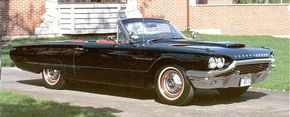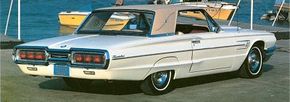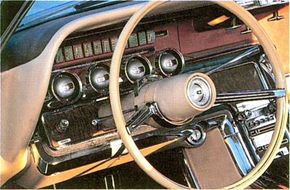The fourth generation 1964-1966 Ford Thunderbird models were not far removed from the third generation, retaining the same basic understructure and unit-body inner stampings while wheelbase increased fractionally to 113.2 inches.
Advertisement
But a complete reskinning vastly altered them on the surface. "There's a more powerful look which the stylists obtained by lengthening the hood and shortening the roof lines," said Car Life. "And there's a cleaner, stronger rear, achieved with two of the biggest tail/turn/stop lamps ever seen on an automobile."
The turn signals of the 1964 were intended to be sequential, but Ford ran into trouble with certain state regulations and was forced to wait a year while applying for the necessary permissions.
In detail, the 1964 retained a family resemblance to the 1963 but was obviously new. The pointed profile was still evident, but from front or rear it was completely altered. The quad headlamps were moved to the extreme edge of the fenders, where they cut into the face of the car in canted oval cutouts.
The rear end was the best design element, set off by two oblong taillights surrounded by protective bumpers. A lower pan, painted body color, contained the backup lights. The decklid retained the "twin-pontoon" theme of earlier models. Under it was a new "deep well" trunk, which gave much more luggage space, carrying the spare tire well forward.
The 1964 roofline retained the formal air of the past, but, taking advantage of a low-pressure area behind the backlight, now featured Silent-Flo, the first windows-closed, flow-through ventilation system on an American car. With a console lever, the driver could actuate a vacuum servo that opened a vent under the rear window.
This helped blast fresh air through the car. Flow-through ventilation had been introduced by Mercedes on its 1954 300SL gullwing coupe, and Mercury had used the meat-ax approach to create it with its retractable backlights in 1957, but the Thunderbird's was an elegant, functional design, and was soon widely imitated.
Designers had created more room in the 1964 Thunderbird, but it probably didn't matter. The typical Thunderbirder was a front-seat dweller. Nestled in a big vinyl bucket, restrained by a seatbelt extending from a retractable reel built into the seat edge, and surrounded by levers, buttons, dials and wheels, the driver was confronted with all the gimmicks at Dearborn's command.
It was an experience Car Life described as "begadgeted and bedazzling ... It should keep boys of all ages occupied." Ford ads repeated the slogan, "Flight plan cleared -- proceed to Thunderbird."
Continue reading to find out more about eventual design and performance changes to the Ford Thunderbird.
For more information on cars, see:
- Classic Cars
- Muscle Cars
- Sports Cars
- Consumer Guide New Car Search
- Consumer Guide Used Car Search
Advertisement


